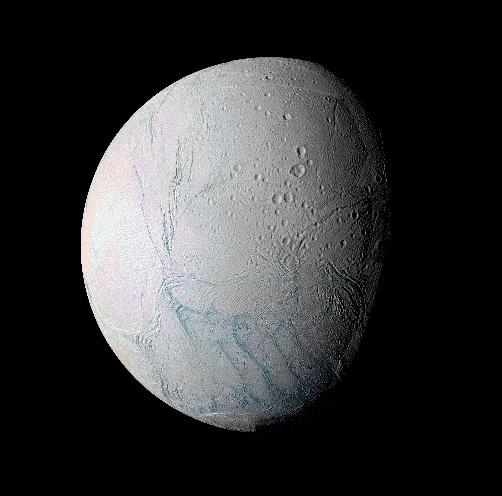Zooming in on Enceladus

| PIA Number | PIA06253 |
|---|---|
| Language |
|
As it swooped past the south pole of Saturn's moon Enceladus on July 14, 2005, Cassini acquired increasingly high-resolution views of this puzzling ice world. These views have been combined into this exciting movie sequence. The movie provides a stunning, up-close look at what is surely one of the youngest surfaces in the Saturn system.
From afar, Enceladus exhibits a bizarre mixture of softened craters and complex, fractured terrains. The movie zooms in on the southern polar terrains and closes in on one of the tectonic stripes that characterize this region which is essentially free of sizeable impact scars.
The bright oblong area seen during the zoom is an intermediate resolution image from near the time of closest approach that has been melded into the lower resolution mosaic, and artificially brightened.
The movie ends on the highest resolution image acquired by Cassini which reveals a surface dominated by ice blocks between 10 and 100 meters (33 and 330 feet) across, lying in a region that is unusual in its lack of the very fine-grained frost that seems to cover the rest of Enceladus.
The lack of frost and the absence of craters are indicators of a youthful surface.
The initial image in the movie is a large mosaic of 21 narrow-angle camera images that have been arranged to provide a full-disk view of the anti-Saturn hemisphere on Enceladus. This mosaic is a false-color view that includes images taken at wavelengths from the ultraviolet to the infrared portion of the spectrum, and is similar to another, lower resolution false-color view obtained during the flyby (see Enceladus in False Color). In false-color, many long fractures on Enceladus exhibit a pronounced difference in color (represented here in blue) from the surrounding terrain.
A leading explanation for the difference in color is that the walls of the fractures expose outcrops of coarse-grained ice that are free of the powdery surface materials that mantle flat-lying surfaces.
The original images in the false-color mosaic range in resolution from 350 to 67 meters (1,148 to 220 feet) per pixel and were taken from distances ranging from 61,300 to 11,100 kilometers (38,090 to 6,897 miles) from Enceladus. The mosaic is also available separately (see Zooming in on Enceladus -- Mosaic).
Image scale is about 37 meters (121 feet) per pixel in the wide-angle camera image and about 4 meters (13 feet) per pixel in the narrow-angle image (see Boulder-strewn Surface for these images). Both of these ultra-high resolution views were acquired from an altitude of approximately 208 kilometers (129 miles) above Enceladus as the spacecraft near the time of closest approach during the flyby.
The Cassini-Huygens mission is a cooperative project of NASA, the European Space Agency and the Italian Space Agency. The Jet Propulsion Laboratory, a division of the California Institute of Technology in Pasadena, manages the mission for NASA's Science Mission Directorate, Washington, D.C. The Cassini orbiter and its two onboard cameras were designed, developed and assembled at JPL. The imaging operations center is based at the Space Science Institute in Boulder, Colo.
For more information about the Cassini-Huygens mission visit http://saturn.jpl.nasa.gov . The Cassini imaging team homepage is at http://ciclops.org .
Credit: NASA/JPL/Space Science Institute
